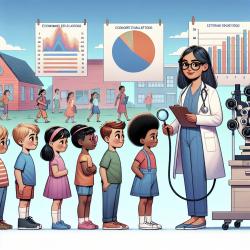Introduction
Vision impairment in children, particularly amblyopia and refractive errors, is a global concern affecting the quality of life and imposing financial burdens on families and health systems. Early detection through vision screening is crucial, yet the economic viability of such programs remains a topic of debate. The systematic review titled "Economic evaluations of vision screening to detect amblyopia and refractive errors in children" provides a comprehensive analysis of the cost-effectiveness of these screenings, offering valuable insights for practitioners.
Key Findings from the Research
The review synthesizes data from 13 studies across five countries, evaluating various economic models of vision screening. It highlights that vision screening can be cost-effective, particularly when implemented in early childhood settings such as preschools and kindergartens. Key outcomes include:
- Incremental cost-effectiveness ratios (ICERs) ranged significantly, suggesting variability in cost-effectiveness based on the screening method and country context.
- Screening was generally more cost-effective when performed by trained professionals or volunteers in educational settings.
- High-quality studies often utilized cost-utility and cost-effectiveness analyses, indicating these methods provide robust economic evaluations.
Implications for Practitioners
For practitioners, these findings emphasize the importance of integrating vision screening into early childhood health assessments. Here are some actionable steps based on the research:
- Advocate for Policy Support: Encourage policymakers to support vision screening programs by presenting evidence of their cost-effectiveness and potential to improve children's quality of life.
- Collaborate with Schools: Partner with educational institutions to implement screening programs, leveraging their infrastructure and access to children.
- Utilize Trained Personnel: Employ trained professionals or volunteers to conduct screenings, ensuring accuracy and reliability of results.
- Focus on High-Risk Populations: Target screenings in communities with higher prevalence of vision impairments to maximize impact and cost-effectiveness.
Encouragement for Further Research
While the review provides a strong foundation, it also identifies gaps and methodological limitations in current studies. Practitioners are encouraged to engage in further research to address these gaps, particularly in understanding the long-term impact of amblyopia on quality of life and refining cost-utility models.
To read the original research paper, please follow this link: Economic evaluations of vision screening to detect amblyopia and refractive errors in children: a systematic review.










